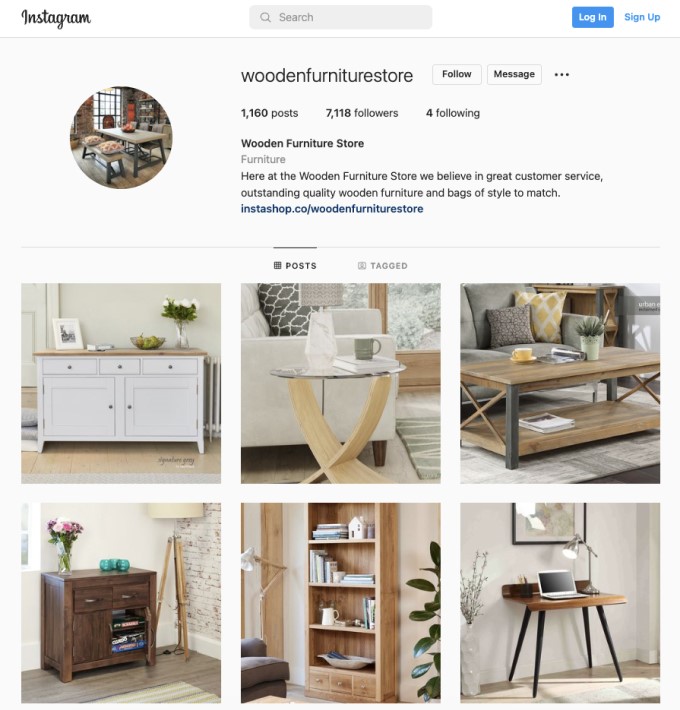Do you have pre-loved furniture pieces waiting for a new home, or a collection of stylish items that can elevate any room’s decor? Our comprehensive guide on selling furniture online covers all the strategies you need to successfully transition your inventory from your store to your customers’ homes. Let’s see How to Sell Furniture Online in 9 Simple Steps.
According to Statista, the global furniture market is projected to reach US$499,216 million by 2022, with an expected 1,788 million consumers by 2025. This growth highlights the significant role of eCommerce in the industry’s expansion.
Starting an online furniture business is more cost-effective and less time-consuming than opening a physical store. The pandemic has shifted consumer behavior, making online furniture shopping more popular as people prefer the convenience of ordering from home.
While offline furniture stores require ample space to display products, online stores face no such constraints, allowing you to showcase a wider range of items on your website or app. The US, with an estimated $116 billion in revenue in 2018, is the largest furniture market globally, and entering this industry is surprisingly straightforward.
Selling furniture online is not a complex process; you just need to know the right steps. Let’s dive into the seven simple procedures for selling furniture online.
1. Choose a Niche
Given the competitive nature of the furniture market, it’s crucial to find a niche and position yourself as the go-to choice for a specific clientele. For example, some furniture sellers focus on creating and marketing unique, handmade items tailored to their clients’ needs.
Others might specialize in furniture made entirely from recycled wood and eco-friendly materials. Your niche decision will be influenced by factors such as:
- Use: Home accents, office furniture, outdoor furniture, and interior furnishings
- Products: Bed frames, sofa beds, lounge chairs, dining tables, and chairs
- Styles: Shabby chic, rustic, modern, and minimal
- Make: Recycled materials, smart furniture, and modular pieces
- Customer: Families, renters, condo owners, and college students
- Cause: Ethical sourcing, locally made products, and sustainable furniture
Less competition means fewer concerns for you, but avoid narrowing your niche too much to ensure you attract a broad enough customer base.
When selling furniture online, consider these categories:
- Recliners and chairs
- Divans and beds
- Wardrobes and dressers
- Couches, sofa sets, and futons
- Dining tables
You might also offer furniture rental options, which are popular with urban millennials. Additionally, there’s a significant market for used furniture, so selling second-hand items online is another viable option.
Before launching your online furniture business, take time to research your competitors. Consider the following questions:
- Who are the current businesses selling furniture online?
- Who are their target customers?
- What is their current market share?
Answering these questions will provide a realistic picture of the competition and help you develop your business’s unique selling proposition (USP) compared to mass-market rivals.

2. Decide Your Business Model
There are several ways to enter the furniture industry. Here are some popular business models for selling furniture online:
- Self-Manufacturing This involves designing and building furniture in your own workshop or retail space. You’ll need a dedicated workspace, specialized equipment, and technical know-how. You can either maintain stock of popular designs or offer personalized services, allowing customers to choose specific styles and features.
- Self-Designing In this model, you create the designs for another manufacturer to produce. You’ll need drafting skills and equipment to develop detailed furniture blueprints.
- Reselling This model involves marketing furniture pieces made by various companies or brands. Some curators specialize in specific types of furniture, such as items from a particular design era or by a specific manufacturer. As a curator, you’ll need to be skilled at sourcing high-quality furniture that you can sell profitably. This is a great option if you focus on vintage furniture pieces. You’ll need extensive knowledge of vintage furniture and ample inventory space. The process includes photographing items, storing them safely until sold, and shipping them to buyers.
Choosing the right business model depends on your skills, resources, and market knowledge. Each model has its unique requirements and advantages, so consider which aligns best with your strengths and goals.
4. Dropshipping
Dropshipping is a business model where you don’t need to store or transport the furniture products you sell online. Instead, you partner with manufacturers and brands who handle inventory, packaging, and shipping directly to your customers. This approach is perfect for those starting their business, as it eliminates the hassle of managing stock and logistics.

3. Find a Manufacturer
If you decide to resell furniture instead of creating your own line, finding a skilled manufacturer is essential. Ensure that the manufacturer you choose:
- Has in-depth knowledge of the market and various product categories.
- Can help you stay closely connected to the manufacturing and supply chain cycles.
- Is capable of timely product delivery.
- Can produce furniture for your online shop at a cost that is affordable for you.
Conduct a market study to identify suppliers and producers who can provide high-quality furnishings. As you search for inventory, consider these sources:
- Auctions: Regional auctions often feature vintage and collectible furniture. Join local social media networks to stay informed about auctions, or explore online auction sites like eBay to bid at your convenience.
- Flea Markets: Flea markets can be treasure troves for furniture resellers. Arriving early increases your chances of finding great deals.
- Collectors: Private collectors might be willing to sell their pieces, though you may need to pay a premium. As you build your reputation as a furniture merchant, you’ll naturally connect with collectors.
- Wholesale Markets: Websites like Handshake offer unique, stylish furniture at discounted rates. You don’t need to make large minimum purchases, making it easier to stock your inventory.
While there are many trustworthy wholesalers and drop shippers, be cautious of scammers posing as legitimate businesses. Thoroughly research potential partners, focusing on those with reliable ratings, affordable prices, and high-quality products.
4. Prepare a Location for Inventory
When building or buying furniture to sell online, it’s crucial to consider the space needed for storage. The region’s temperature and other conditions should influence your decision on how and where to store your furniture.
Extreme temperatures, pests, and humidity fluctuations can damage furniture materials, especially wood and organic textiles. If you’re just starting out, you can designate a space in your home for storage. For larger inventories, renting a climate-controlled storage unit is a viable option.
Here are your furniture storage and warehousing options:
- Renting a climate-controlled storage space.
- Utilizing a business warehouse for large, heavy items like dining tables and beds.
- Purchasing a dedicated warehouse or storage area.
5. Price Your Furniture
Setting the right price for your furniture, whether selling online or offline, is crucial. It should be attractive enough to generate offers while ensuring you make a significant profit. This requires thorough research and a deep understanding of the market.
Start by researching similar products being sold online to gauge their prices. If your item is unique, such as a valuable antique, consider getting an estimate from a vintage or antique dealer.
Additionally, factor in any extra costs beyond the item’s value. For example:
- Packaging and Shipping: Will you offer free shipping and absorb the cost, or will you charge the customer?
- Insurance: Does the transportation of your goods require insurance?
- Local Delivery: Will you provide delivery for nearby purchases, and if so, will it be free?
All these considerations will influence the final price you set for your furniture.
6. Choose Where to Sell Furniture Online
With various options available, deciding where to sell furniture online can seem overwhelming. The best platform depends on how much and how often you plan to sell.
- Online Marketplaces: Ideal for selling one or two unwanted items. These platforms are user-friendly and have a broad audience.
- eCommerce Stores: Perfect if you want to sell furniture as a hobby or small business. They offer more control over branding and customer experience.
The three most efficient ways to sell furniture online are:
- Social Media:

Leverage platforms like Facebook, Instagram, and Pinterest to reach potential buyers. Social media allows for direct interaction with customers and can help build a loyal following.
- Online Marketplaces: Websites like eBay, Etsy, and Amazon are great for reaching a wide audience. These platforms handle many aspects of the sales process, making it easier for you to manage.
- eCommerce Stores: Creating your own online store using platforms like Shopify, WooCommerce, or BigCommerce gives you full control over your business. This option is best for those looking to establish a long-term presence in the market.
Each option has its advantages, so choose the one that best fits your needs and goals.
7. Listing Your Furniture Online
When selling furniture online, it’s essential to present your products in the best possible light since customers can’t physically inspect them. The aesthetics of your online store play a significant role in influencing purchase decisions. Here are some key types of content to include:
Product Images
To sell your furniture quickly, it needs to look appealing. Arrange the furniture in a room setting to showcase its potential. This helps buyers visualize how the furniture might fit in their own homes, particularly in terms of space.
- Lighting: Use good lighting to take photos from various angles. Proper lighting makes the furniture look clean and attractive, while poor lighting can make it appear dirty and unappealing.
- Angles: Display the furniture from the front, sides, and back with detailed photographs. This allows potential buyers to see every aspect of the piece.
- Close-ups: Take close-up shots to highlight the quality and details, such as the metalwork on a bed frame or the texture of a sofa’s fabric. Always use high-definition, crystal-clear images.
Product Description
Furniture purchases require careful consideration, unlike more convenient items like clothing or books. Therefore, detailed descriptions are crucial.
Include the following information:
- Measurements: Provide precise dimensions of the furniture.
- Guarantee Details: Mention any warranties or guarantees.
- Delivery Period: Estimate the delivery time.
- Maintenance Guidelines: Offer tips on how to care for and maintain the furniture.
By providing comprehensive images and descriptions, you can help customers make informed decisions and increase the likelihood of a sale.
8. Shipping
Shipping furniture, regardless of its size, requires meticulous care and attention. Customers expect their purchases to arrive promptly and in perfect condition, which adds to the complexity of shipping and delivery.
Certain furniture pieces can take up a lot of space in a truck, increasing logistics costs. Therefore, it’s crucial to choose your delivery partners or companies wisely.
Your delivery partners should:
- Have the capability to transport large, heavy items over long distances.
- Ensure protection of the items during transit with appropriate packaging to prevent damage.
By selecting reliable delivery partners, you can ensure that your furniture reaches customers safely and efficiently.
9. Market Your Business
Once you’ve set up your online furniture store, the next step is to make potential customers aware of your products. Here are some strategies to effectively market and sell your furniture online:
Use Relevant Keywords
Ensure you’re using popular and relevant keywords in your listings. This helps your products appear in search results, making it easier for customers to find what they’re looking for.
Meet Customer Expectations
Provide what your customers are asking for. Satisfied customers are more likely to leave positive reviews, which can improve your rankings and boost sales.
Marketing Techniques for Your eCommerce Store
If you run your own eCommerce site, consider these techniques to market your furniture:
- Social Media Marketing: Use platforms like Instagram, Facebook, and Pinterest to showcase your furniture. High-quality images and engaging posts can attract potential buyers.
- Email Marketing: Send newsletters and promotional offers to your subscribers to keep them informed about new arrivals and special deals.
- Content Marketing: Create blog posts, videos, and guides related to home decor and furniture care. This can drive traffic to your site and establish your brand as an authority in the industry.
- Search Engine Optimization (SEO): Optimize your website content to rank higher in search engine results. This includes using relevant keywords, creating quality content, and ensuring your site is user-friendly.
- Paid Advertising: Invest in online ads through Google AdWords, social media platforms, or other advertising networks to reach a broader audience.
By implementing these strategies, you can increase visibility for your furniture and drive more sales.
Best Expert Tips on Reselling Furniture
1. Offer Discounts
Many shoppers are attracted to discount codes, which can bring additional customers to your online store and increase the number of potential buyers for your other products. To boost your furniture sales, monitor seasonal marketing trends and offer deals and discount codes to your clients.
2. Provide Reliable Customer Support
Always seek feedback from your customers. Offer free furniture assembly and post-purchase support to help with any issues they might encounter. Provide multiple contact options, such as email, phone, and direct messaging on social media, to prevent negative comments from appearing on your website or social media accounts.
3. Share Customer Testimonials
Customer feedback is crucial for a furniture brand, especially since online shoppers can’t inspect the product’s quality in person. Encourage satisfied customers to leave reviews on social media, which you can then use in your marketing campaigns and online store.
4. Keep Your Inventory Up-to-Date
Regularly monitor and update your product catalog to reflect demand and customer feedback. Many eCommerce businesses fail due to neglecting this aspect. Ensure your inventory includes both popular items and emerging products that are gaining popularity. If you find complementary products to your best-sellers, add them to your inventory and see if customers are interested.
5. Restock Popular Pieces
Always maintain a supply of your best-selling items. Experiment with new variations of popular products while keeping the successful ones in stock. This helps determine if customers like the new options. If you have an existing customer base, consider introducing a new niche of furniture products to explore potential expansion opportunities.
By following these tips, you can enhance your furniture reselling business and attract more customers.
Conclusion
Recent industry trends show that eCommerce is set to dominate in terms of order volume and revenue as customers are eager to spend again. This detailed guide highlights the importance of understanding your customers’ needs to successfully sell furniture online.
As we’ve discussed, avoiding common mistakes is key, and breaking down the process into manageable steps makes starting a business less daunting and more enjoyable.Continuous learning is essential. You won’t be perfect at the beginning, but being adaptable and open-minded puts you on the path to success. The final step is to dive in and launch your new business with full commitment! Having completed our nine stages of selling furniture online, you now know how to create your own online furniture store. We hope this guide has equipped you with the knowledge to start or expand your eCommerce business. Your customers are out there, waiting for you, even if they don’t realize it yet. So don’t hesitate—start building your furniture business today, and you’ll soon see your efforts pay off with increased sales.
FAQs
1. Is it a good idea to sell furniture online?
Yes, starting an online furniture business is a smart move due to the projected growth in eCommerce over the coming years. Selling furniture online can be highly profitable if done correctly. Platforms like Grocito allow you to start your furniture business online quickly and easily.
2. Are there restrictions on what type of furniture I can sell on my online store?
No, there are no restrictions on the type of furniture you can sell on your own eCommerce store. Unlike marketplaces like Etsy, which restricts sales to handmade, vintage, or craft materials, a dedicated eCommerce platform like Grocito lets you sell both modern and vintage furniture, as well as home accessories.
3. How can I safely sell furniture online?
To ensure a safe and secure customer experience, choose the right platform for your business website, post clear product photographs and descriptions, and use a reliable payment channel. Grocito offers all the eCommerce features you need to run a successful online furniture business.
4. Can my online furniture business turn profitable?
Absolutely! Selling furniture online can be very lucrative. To maximize your profits, invest in an economical eCommerce platform that doesn’t charge high transaction fees and includes essential features without hidden costs. Grocito is recommended for launching your online furniture business.
5. What is the best way to sell furniture on the Internet?
The best way to sell furniture online is through your own eCommerce store. Invest in marketing activities and build a strong social media presence to increase visibility and drive traffic to your store.




